Symbiotic Combination and Accumulation of Coal Measure Gas in the Daning–Jixian Block, Eastern Margin of Ordos Basin, China
Abstract
:1. Introduction
2. Regional Geology Setting
3. Symbiotic Combination and Type of Coal Measure Gas Reservoirs
3.1. The Lithofacies Combination Patterns and Sedimentary Environment of Coal Measure Strata
3.1.1. Lithofacies Combination Patterns
3.1.2. Sedimentary Environment
3.2. Combination and Distribution of the Coal Measure Gas Reservoir
4. Symbiotic Combination and Type of Coal Measure Gas Reservoirs
4.1. The Enrichment and Accumulation of Coal Measure Gas
4.2. Enrichment of Coal Measure Gas
4.2.1. Enrichment of Coal Measure Gas Based on the Superimposed Gas-Bearing System
- In-source enrichment mode
- Near-source migration enrichment mode
- Far-source preservation enrichment mode
4.2.2. Characteristics of Coal Measure Gas Enrichment
4.3. Evolution and Symbiotic Accumulation of Coal Measure Gas
5. Conclusions
- Based on the superposition relationship of coal measure strata in the study area, the symbiotic characteristics of coal measures can be divided into eight types of lithofacies and six types of gas reservoir. As the material basis of gas reservoirs, coal and shale are the main source rocks; controlled by the sedimentation of tidal flat-lagoon facies, the “sand-mud-coal” type is mainly distributed in P1s2 and P1t, with good gas-bearing indication, and the tight sandstone gas is mainly distributed in P2s8 in an underwater distributary channel.
- A differential display of the total hydrocarbon content and pressure coefficient of the coal measure reservoir gas survey, identification of key strata, and four superposed gas-bearing systems are developed vertically (the lower part of P2s8, the middle and lower part of P1s1, the upper and lower part of P1s2, and the coal seam of P1t). According to the relationship between the gas-bearing system and the gas reservoir, the enrichment of coal-bearing gas reservoirs in the study area are further divided into three modes: in-source enrichment mode, near-source migration enrichment mode, and far-source migration enrichment mode.
- The formation of coal measure gas reservoirs is the comprehensive result of enrichment–destruction–re-accumulation in each historical period. Models of coal measure gas symbiotic accumulation are further proposed in this study, including “Adjacent to co-source reservoir” type superimposed coalbed methane and shale gas reservoirs, “Three gas symbiosis” superimposed reservoirs in local gas-bearing systems, and “co-source far reservoir” tight sandstone gas reservoirs. The determination of the symbiotic relationship of coal-based gas reservoirs will facilitate the clarification of the exploration direction.
Author Contributions
Funding
Data Availability Statement
Acknowledgments
Conflicts of Interest
References
- Law, B.E. Introduction to unconventional petroleum systems. AAPG Bull. 2002, 86, 1851–1852. [Google Scholar] [CrossRef]
- Moore, T.A. Coalbed methane: A review. Int. J. Coal Geol. 2012, 101, 36–81. [Google Scholar] [CrossRef]
- Song, R.; Su, Y.F.; Chen, X.D. Progress and Research on exploration and development of “three gas” resources of deep coal measure in Shanxi Province. Coal Geol. China 2019, 31, 53–58. [Google Scholar]
- Zou, C.; Yang, Z.; Huang, S.; Ma, F.; Sun, Q.; Li, F.; Pan, S.; Tian, W. Resource types, formation, distribution and prospects of coal-measure gas. Pet. Explor. Dev. 2019, 46, 451–462. [Google Scholar] [CrossRef]
- Peck, C. Review of Coalbed Methane Development in the Powder River basin of Wyoming/Montana. In SPE Rocky Mountain Regional Meeting; OnePetro: Richardson, TX, USA, 1999; Volume 9. [Google Scholar] [CrossRef]
- Cumella, W.F.W.S.P.; Revil, A. Piceance Basin Mesaverde anomalous self-potential response: Identification of capillary seals in a basin-centered gas accumulation. AAPG Bull. 2017, 101, 19–37. [Google Scholar] [CrossRef]
- Qin, Y. Research progress of symbiotic accumulation of coal measure gas in China. Nat. Gas Ind. B 2018, 5, 466–474. [Google Scholar] [CrossRef]
- Su, X.; Li, F.; Su, L.; Wang, Q. The experimental study on integrated hydraulic fracturing of coal measure gas reservoirs. Fuel 2020, 270, 117527. [Google Scholar] [CrossRef]
- Jia, J.; Cao, L.; Sang, S.; Yi, T.; Zhou, X. A case study on the effective stimulation techniques practiced in the superposed gas reservoirs of coal-bearing series with multiple thin coal seams in Guizhou, China. J. Pet. Sci. Eng. 2016, 146, 489–504. [Google Scholar] [CrossRef]
- Meng, S.; Li, Y.; Wang, L.; Wang, K.; Pan, Z. A mathematical model for gas and water production from overlapping fractured coalbed methane and tight gas reservoirs. J. Pet. Sci. Eng. 2018, 171, 959–973. [Google Scholar] [CrossRef]
- Tang, S.; Tang, D.; Liu, S.; Li, S.; Tang, J.; Wang, M.; Zhang, A.; Pu, Y. Multiscale pore characterization of coal measure reservoirs and gas storage and transport behavior in Yanchuannan gas field of China. AAPG Bull. 2022, 106, 2387–2415. [Google Scholar] [CrossRef]
- Bustin, A.; Bustin, R. Contribution of non-coal facies to the total gas-in-place in Mannville coal measures, Central Alberta. Int. J. Coal Geol. 2016, 154–155, 69–81. [Google Scholar] [CrossRef]
- Geng, L.; Zhaobiao, Y.; Wei, G.; Zhengguang, Z.; Bingren, J.; Benju, L. Characteristics of Coal-Measure Gas Reservoirs in Thin Interbedded Marine–Continental Transitional Facies and Optimization of Combined Production: Examples from the Tucheng Syncline in Western Guizhou. Nat. Resour. Res. 2022, 31, 1503–1522. [Google Scholar] [CrossRef]
- Xi, Z.D.; Tang, S.H.; Yang, G.Q.; Li, L.; Gong, M.H.; Wang, K.Y.; Zhang, B.M. Accumulation and combination characteristics of coal measure gas of Shaoyang depression in the central Hunan. J. China Coal Soc. 2018, 43, 1589–1597. [Google Scholar] [CrossRef]
- Ouyang, Y.; Tian, W.; Sun, B.; Wang, B.; Qi, L.; Sun, Q.; Yang, Q.; Dong, H. Accumulation characteristics and exploration strategies of coal measure gas in China. Nat. Gas Ind. B 2018, 5, 444–451. [Google Scholar] [CrossRef]
- Tang, X.; Zhang, J.; Shan, Y.; Xiong, J. Upper Paleozoic coal measures and unconventional natural gas systems of the Ordos Basin, China. Geosci. Front. 2012, 3, 863–873. [Google Scholar] [CrossRef]
- Esen, O.; Özer, S.C.; Soylu, A.; Rend, A.R.; Fişne, A. Geological controls on gas content distribution of coal seams in the Kınık coalfield, Soma Basin, Turkey. Int. J. Coal Geol. 2020, 231, 103602. [Google Scholar] [CrossRef]
- Li, J.; Tang, S.; Zhang, S.; Li, L.; Wei, J.; Xi, Z.; Sun, K. Characterization of unconventional reservoirs and continuous accumulations of natural gas in the Carboniferous-Permian strata, mid-eastern Qinshui basin, China. J. Nat. Gas Sci. Eng. 2018, 49, 298–316. [Google Scholar] [CrossRef]
- Jiang, Y.; Hu, H.; Gluyas, J.; Zhao, K. Distribution Characteristics and Accumulation Model for the Coal-formed Gas Generated from Permo-Carboniferous Coal Measures in Bohai Bay Basin, China: A Review. Acta Geol. Sin. Engl. Ed. 2019, 93, 1869–1884. [Google Scholar] [CrossRef]
- Sun, J.; Xiao, X.; Cheng, P. Methane absorption of coal-measure shales with and without pore water from the Qinshui Basin, North China: Based on high-pressure methane absorption experiments. Int. J. Coal Geol. 2022, 263, 104116. [Google Scholar] [CrossRef]
- Zhang, A.; Chen, S.; Tang, D.; Tang, S.; Zhang, T.; Pu, Y.; Sun, B. The Study on Diagenetic Characteristics of Coal Measures Sandstone Reservoir in Xishanyao Formation, Southern Margin of the Junggar Basin. Energies 2022, 15, 5499. [Google Scholar] [CrossRef]
- Shen, J.; Li, K.; Zhang, H.; Shabbiri, K.; Hu, Q.; Zhang, C. The geochemical characteristics, origin, migration and accumulation modes of deep coal-measure gas in the west of Linxing block at the eastern margin of Ordos Basin. J. Nat. Gas Sci. Eng. 2021, 91, 103965. [Google Scholar] [CrossRef]
- Li, Y.; Xu, W.K.; Gao, J.X.; Wu, P.; Tao, C.Q.; Tian, Y.; Li, J.H.; Zhang, Y.L. Mechanism of coal measure gas accumulation under integrated control of “source reservoir—transport system”: A case study from east margin of Ordos Basin. J. China Coal Soc. 2021, 46, 2440–2453. [Google Scholar] [CrossRef]
- Xie, W.; Gan, H.; Chen, C.; Vandeginste, V.; Chen, S.; Wang, M.; Wang, J.; Yu, Z. A model for superimposed coalbed methane, shale gas and tight sandstone reservoirs, Taiyuan Formation, Yushe-Wuxiang Block, eastern Qinshui Basin. Sci. Rep. 2022, 12, 11455. [Google Scholar] [CrossRef]
- Shen, Y.; Qin, Y.; Wang, G.G.; Guo, Y.; Shen, J.; Gu, J.; Xiao, Q.; Zhang, T.; Zhang, C.; Tong, G. Sedimentary control on the formation of a multi-superimposed gas system in the development of key layers in the sequence framework. Mar. Pet. Geol. 2017, 88, 268–281. [Google Scholar] [CrossRef]
- Liu, Q.; Liu, J.; Liang, B. Research into selection evaluation system on co-mining of “the three gas” in coal series stratum. Petroleum 2017, 4, 444–451. [Google Scholar] [CrossRef]
- Zhong, G.; Li, S.; Tang, D.; Tian, W.; Lin, W.; Feng, P. Study on Co-production compatibility evaluation method of multilayer tight gas reservoir. J. Nat. Gas Sci. Eng. 2022, 108, 104840. [Google Scholar] [CrossRef]
- Li, C.; Jiang, B.; Ju, W.; Cheng, G.; Song, Y. Characteristics of tectonic deformation in the Daning–Jixian region, eastern Ordos Basin: Implications for the exploration and development of coalbed methane. Energy Explor. Exploit. 2018, 37, 907–921. [Google Scholar] [CrossRef]
- Zhao, J.; Tang, D.; Xu, H.; Li, Y.; Li, S.; Tao, S.; Lin, W.; Liu, Z. Characteristic of In Situ Stress and Its Control on the Coalbed Methane Reservoir Permeability in the Eastern Margin of the Ordos Basin, China. Rock Mech. Rock Eng. 2016, 49, 3307–3322. [Google Scholar] [CrossRef]
- Ayers, W.B., Jr. Coalbed gas systems, resources, and production and a review of contrasting cases from the San Juan and Powder River basins. AAPG Bull. 2002, 86, 1853–1890. [Google Scholar] [CrossRef]
- Chen, S.; Tang, D.; Tao, S.; Chen, Z.; Xu, H.; Li, S. Coal Reservoir Heterogeneity in Multicoal Seams of the Panguan Syncline, Western Guizhou, China: Implication for the Development of Superposed CBM-Bearing Systems. Energy Fuels 2018, 32, 8241–8253. [Google Scholar] [CrossRef]
- Hou, X.; Zhu, Y.; Yao, H. Coupled accumulation characteristics of Carboniferous-Permian coal measure gases in the Northern Ordos Basin, China. Arab. J. Geosci. 2018, 11, 156. [Google Scholar] [CrossRef]
- Kuang, L.; Wen, S.; Li, S.; Fan, T.; Tian, W.; Wang, X.; Qi, L.; Ying, L.; Mao, D.; Li, X. Accumulation mechanism and exploration breakthrough of low-rank CBM in the Tuha-Santanghu Basin. Nat. Gas Ind. 2022, 42, 33–42. [Google Scholar]
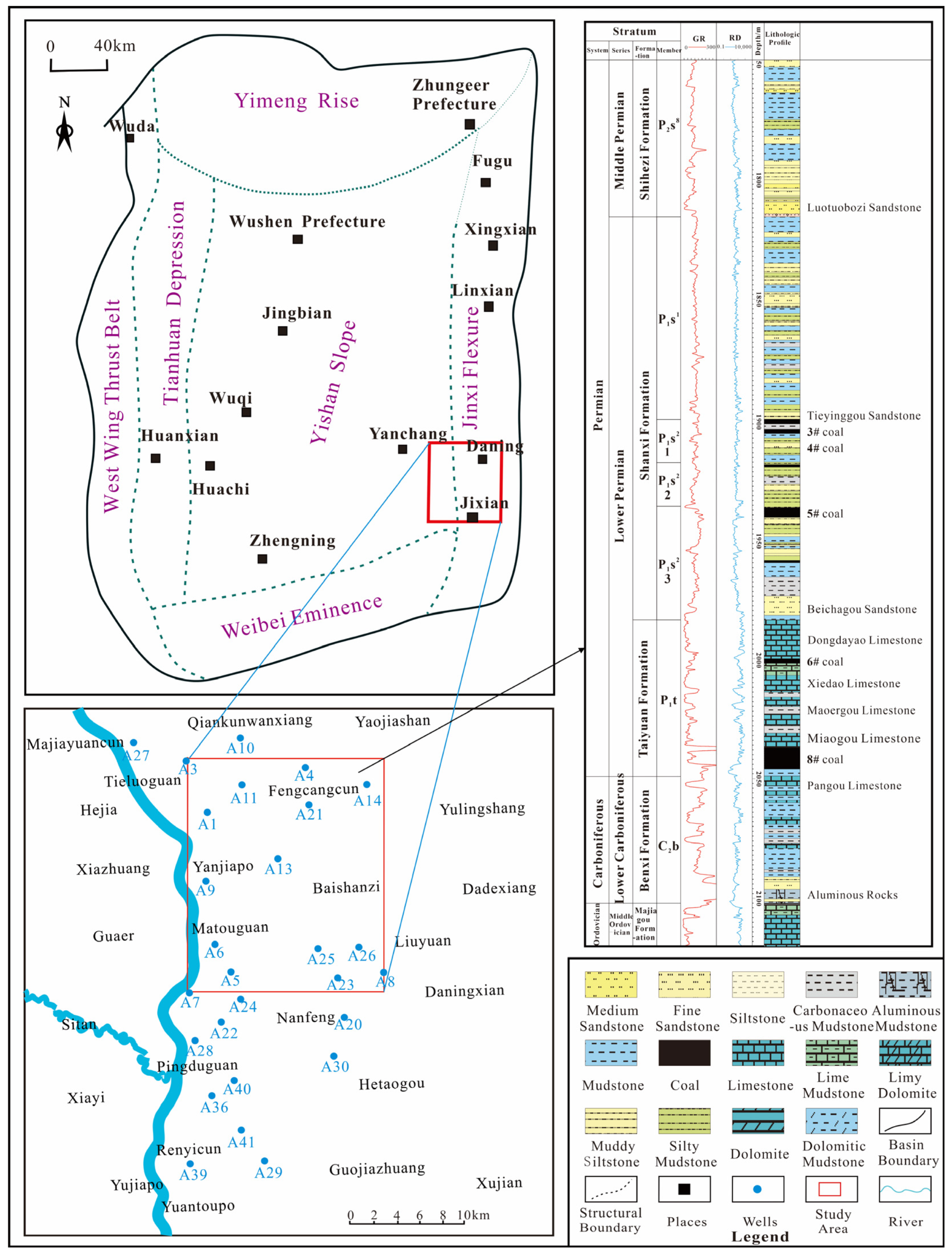
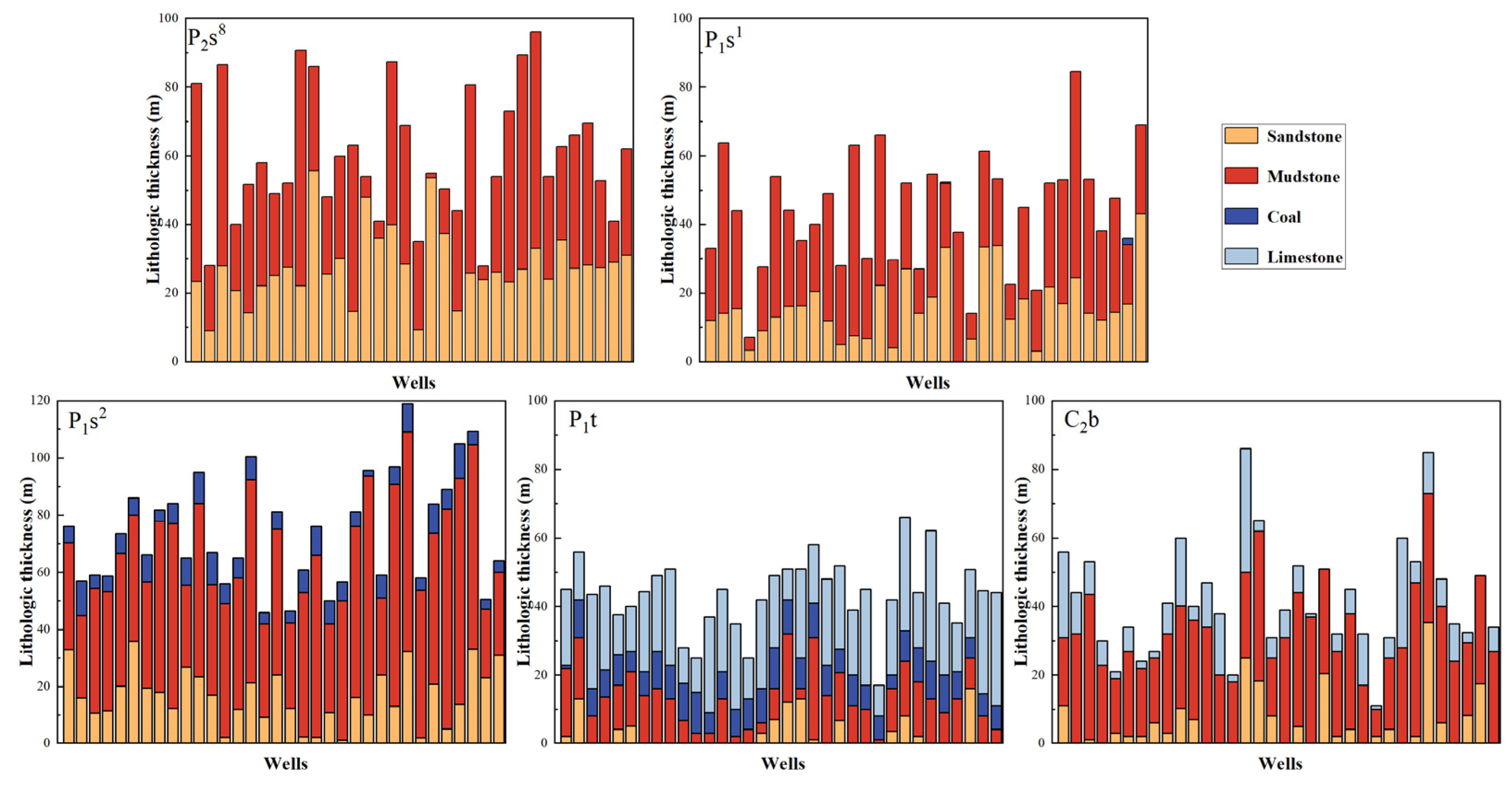


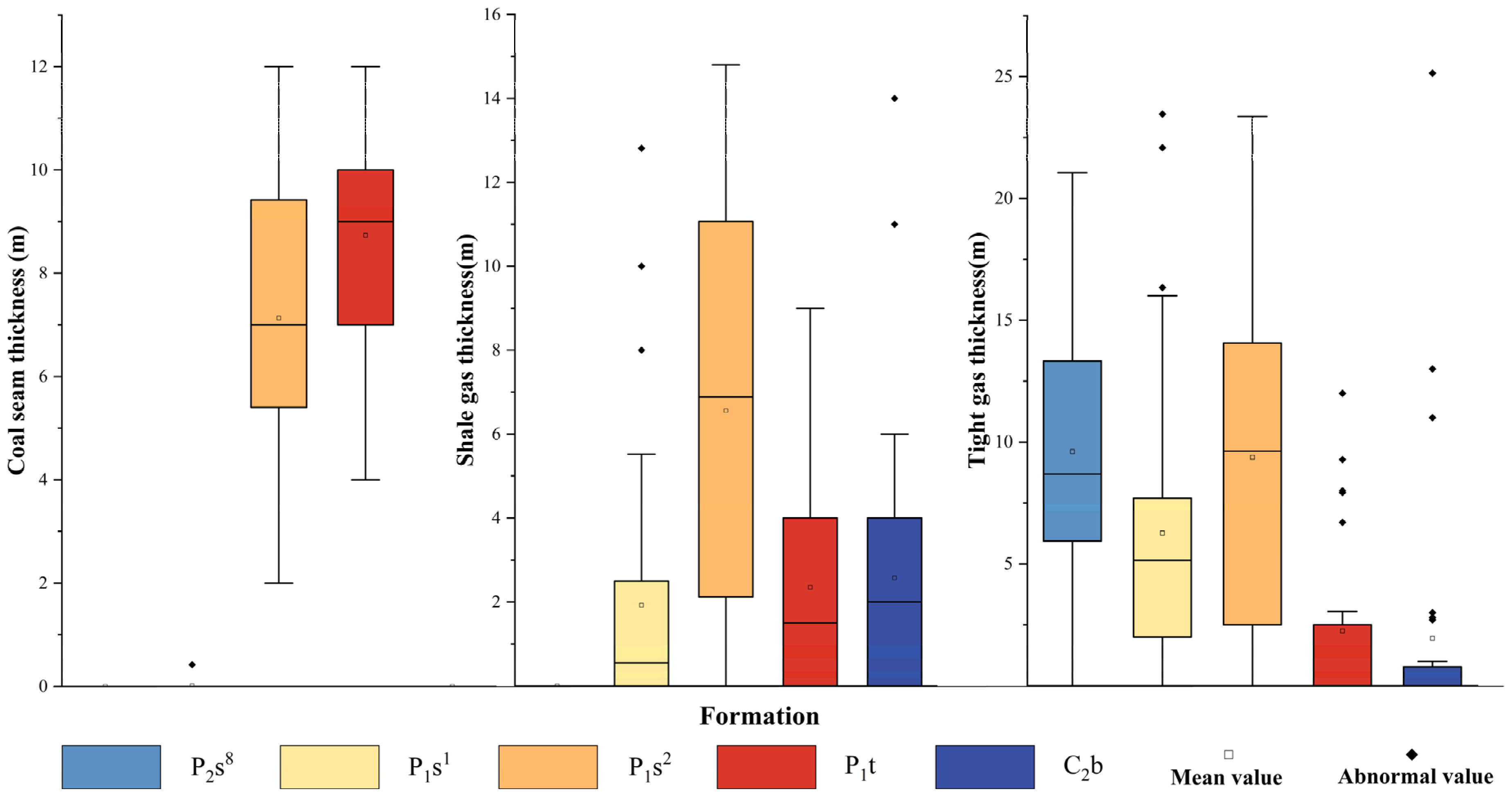

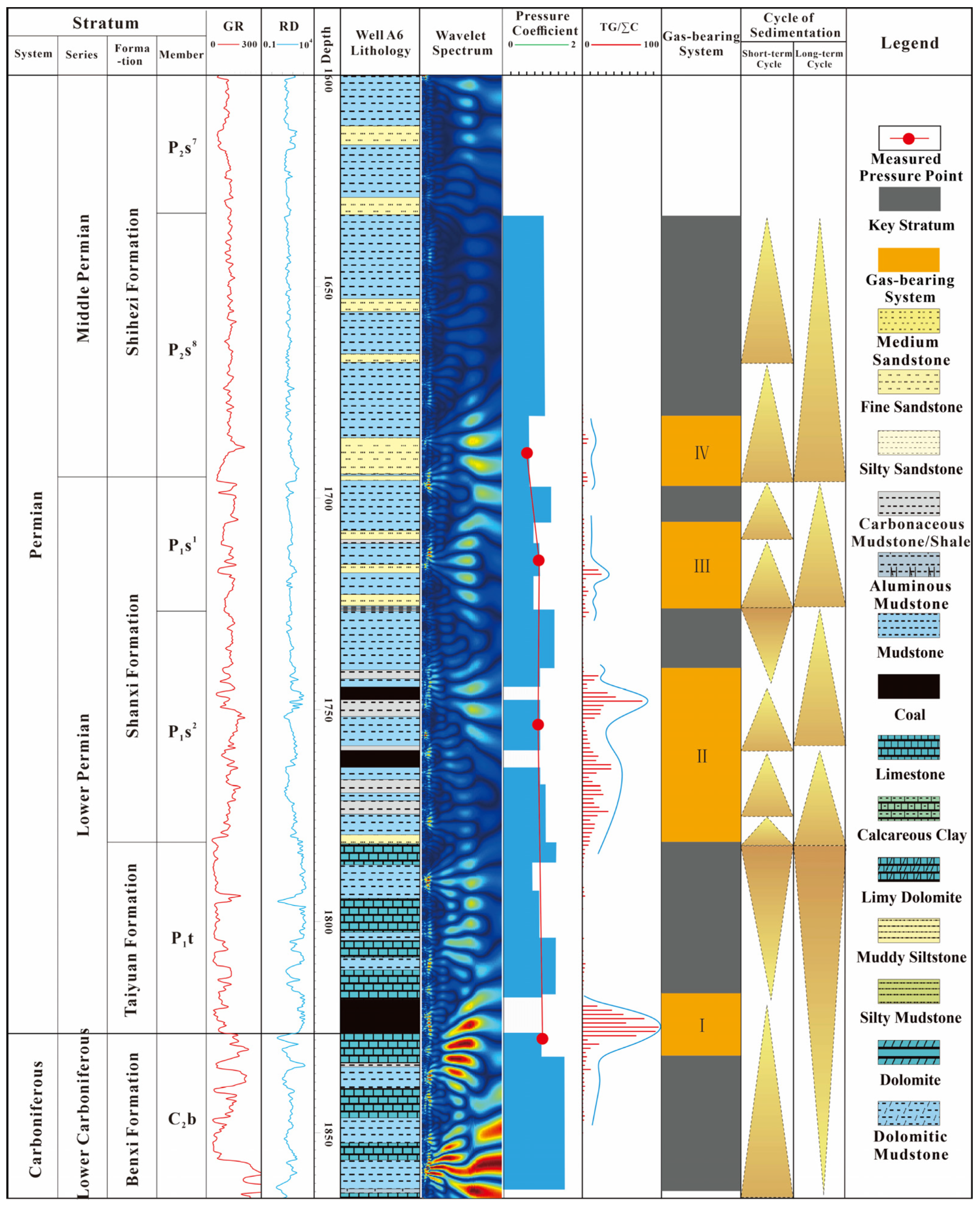

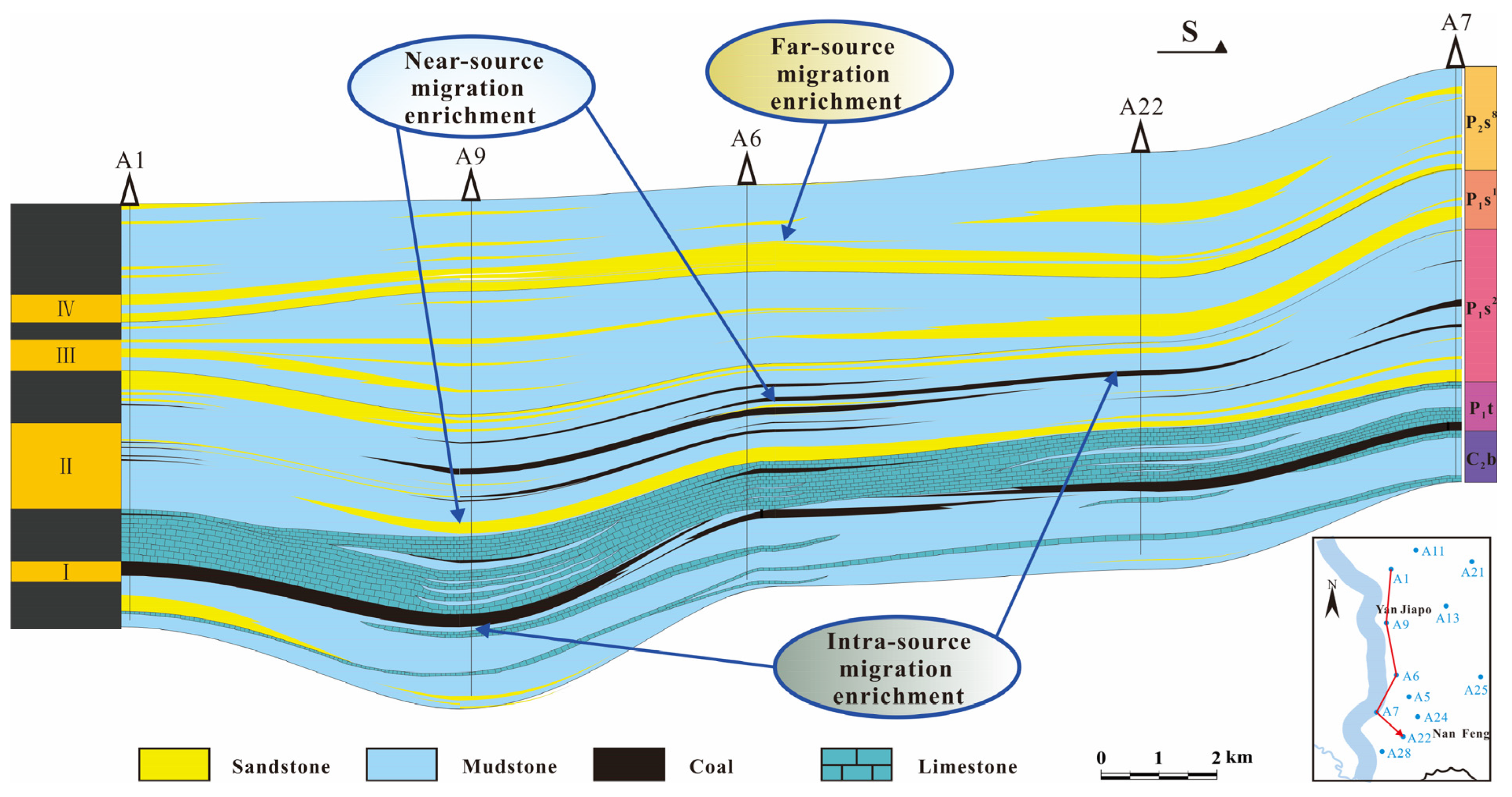
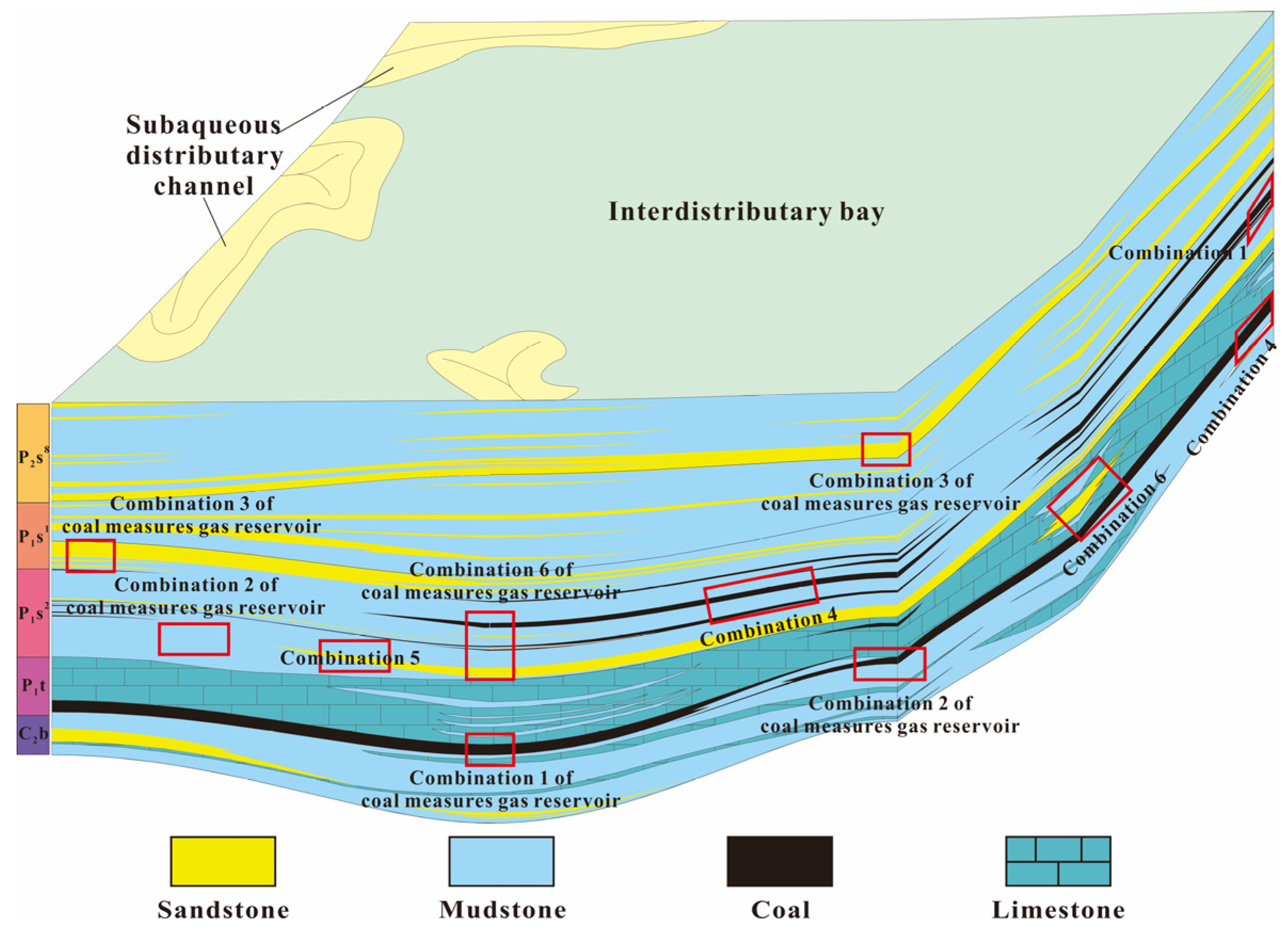
Disclaimer/Publisher’s Note: The statements, opinions and data contained in all publications are solely those of the individual author(s) and contributor(s) and not of MDPI and/or the editor(s). MDPI and/or the editor(s) disclaim responsibility for any injury to people or property resulting from any ideas, methods, instructions or products referred to in the content. |
© 2023 by the authors. Licensee MDPI, Basel, Switzerland. This article is an open access article distributed under the terms and conditions of the Creative Commons Attribution (CC BY) license (https://creativecommons.org/licenses/by/4.0/).
Share and Cite
Tian, W.; Zhao, S.; Tian, F.; Li, X.; Huo, W.; Zhong, G.; Li, S. Symbiotic Combination and Accumulation of Coal Measure Gas in the Daning–Jixian Block, Eastern Margin of Ordos Basin, China. Energies 2023, 16, 1737. https://doi.org/10.3390/en16041737
Tian W, Zhao S, Tian F, Li X, Huo W, Zhong G, Li S. Symbiotic Combination and Accumulation of Coal Measure Gas in the Daning–Jixian Block, Eastern Margin of Ordos Basin, China. Energies. 2023; 16(4):1737. https://doi.org/10.3390/en16041737
Chicago/Turabian StyleTian, Wenguang, Suping Zhao, Fenghua Tian, Xingtao Li, Wanguo Huo, Guanghao Zhong, and Song Li. 2023. "Symbiotic Combination and Accumulation of Coal Measure Gas in the Daning–Jixian Block, Eastern Margin of Ordos Basin, China" Energies 16, no. 4: 1737. https://doi.org/10.3390/en16041737




